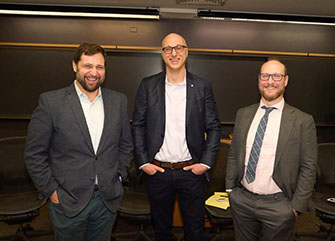Navigating Climate Change Communication
Symposium panelists Yarrow Axford, David Rapp, and Erik C. Nisbet talk misinformation, messaging, and messengers
Symposium Panelists Talk Climate Pollution and Policy

The future of climate regulation in the United States is uncertain, according to a panel of environmental law experts who spoke at the Institute for Sustainability and Energy at Northwestern (ISEN) Annual Symposium. During “Major Questions and the Administrative State: The Future of US Climate Regulation,” panelists analyzed recent proceedings and evolving guidelines.
When it comes to reducing greenhouse gas emissions on a large scale, “we can't pay our way out of climate change—we do need rules that require companies and all of us to change our behavior,” said Robert Weinstock, clinical associate professor at the Northwestern University Pritzker School of Law, and Director of the Environmental Advocacy Center (EAC). “It's not just about accelerating new technologies and spending the money. It can't be. We won't get there.”
What is up in the air is how we will get there.
The 2022 Supreme Court case of West Virginia vs. Environmental Protection Agency (EPA) examined the EPA’s ability to shift power generation from fossil fuels to renewable energy sources. Rather than allowing the EPA’s Clean Power Plan to encourage such generation shifting, the court stripped the agency of the power to do so under the major questions doctrine. According to the panelists, this set the stage for ambiguity around future proceedings.
“This is a quite an important topic, because the major questions doctrine is a newly minted, somewhat uncertain doctrine, which basically says in questions of vast economic and political significance, then Congress has to be extra specific in terms of giving the agency the authority to do something,” said Michael Barsa, professor of practice and Co-Director of the Environmental Law Concentration at Northwestern Law.
According to Senior Director and Lead Counsel of Climate Risk and Clean Power at the Environmental Defense Fund (EDF) Michael Panfil, the case “didn't undermine the EPA's obligation to address climate pollution, but it did suggest that some of the most cost-effective ways to do so are now off the table.”
However, said Panfil, it did remain clear through this case and more recent legislation including the Inflation Reduction Act (IRA) that “EPA has the authority and an obligation to address climate pollution...they need to move forward with urgency and speed.”
Although federal law typically preempts state law, a lack of federal action on this front may diminish future regulation, or open the door for states and smaller, regional agencies to drive the way forward. “What you see is a continued frustration of federal action on climate, and what that means is the only place to advance meaningful climate policy in the United States is at the state and local level,” said Weinstock. “It fragments the policy environment in which corporate and governmental actors interact and makes it difficult to drive big change.”
“It’s going to be very dynamic,” added Barsa. “You might actually end up getting more litigation because now there’s a possibility of all 50 states mounting whatever challenge or lawsuit might be available under that state's law.”
Despite the challenges, there are bright spots with recent action at the state level, including in Illinois. Plus, the panelists shared enthusiasm about the potential of the IRA due to the many incentives it offers that are unlikely to be challenged by the major questions doctrine.
The IRA is “just such transformative legislation...we're already seeing the cost of renewables decline in a way that out-competes other resources and the IRA just accelerates those trends,” said Panfil.
The two pillars of the Institute’s 2021-25 Strategic Plan are Climate and Energy Transition and Resilient Communities. They shaped the Symposium’s two days of panel presentations that brought together industry professionals and leaders, students, community members, and faculty from across more than twenty disciplines. This panel was part of the Symposium’s Climate and Energy Transition.